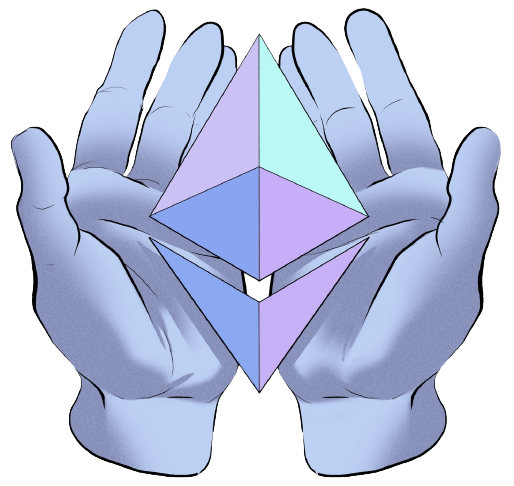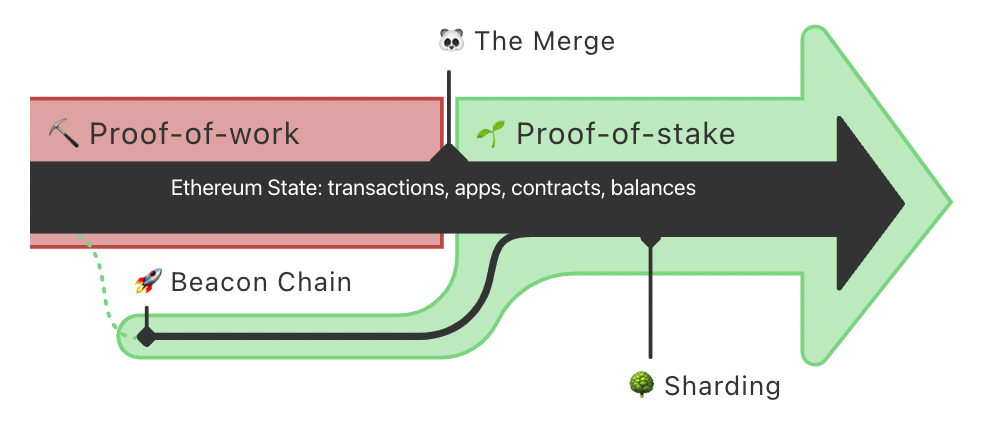Tl;dr – This month the Ethereum network is going through a massive software update. Ethereum’s economic policy will change, its improved framework will better support future updates, and its electricity consumption will collapse by over 99.95%!
Most importantly for you: Zengo customers do not need to take any action, so beware of suspicious people or organizations claiming otherwise. Some services running on the Ethereum network may be paused during The Merge process, and we encourage avoiding important transactions, to be on the safe side.

#1: Ethereum is shifting from a PoW (proof of work) blockchain to a PoS (proof of stake) blockchain
Before Blockchains became popular, most people trusted their money and financial services to centralized entities like banks. A big reason for this is because it’s incredibly difficult to keep track of everyone’s financial transactions without a centralized ledger.
In an oversimplified way: When public and open blockchain technology was figured out, we were then able to have a network of decentralized computers replace centralized banks! They do this by running specialized code that rewards everyone if they update the same “ledger” correctly and all agree on it.
This process can be done a number of ways, 2 of the most popular being: Proof of Work (PoW) & Proof of Stake (PoS).
- In PoW: One “miner” (a computer in the network) gets to “mine” (produce) each block and receive the “block reward” (a number of the native token like Bitcoin or Ether). The way a PoW chain chooses the miner is by having every computer in the network race to guess the answer to a math equation (which is unbelievably difficult) first. This system architecture tends to result in the need for a significant amount of electricity to work.
- In PoS: One “validator” (computer in the network) gets to “validate” (produce) each block and receive the “block reward” (a number of the native token like Ether or MATIC). The way a PoS chain chooses the validator is by having every computer in the network lock up a certain number of the native token, and it selects one at random.
Ethereum has been running on PoW since it began, but a PoS chain, the “Beacon Chain”, was created in December 2020. That chain has been running alongside the network, and is not yet responsible for producing blocks. “The Merge” is when all of the computers in the network update and “Merge” the PoS chain into the main Ethereum network to begin “Validating” instead of “Mining”.

Source: https://ethereum.org/en/upgrades/merge/
#2: Ethereum is about to see a massive drop in energy consumption
Because the difficulty of the equations in PoW are so great, you need incredibly powerful computers to try to guess the answer faster than anyone else. And because these powerful computers are all running non-stop to guess the next equation, they require a lot of electricity.
But in PoS the blockchain randomly chooses a validator instead of making them all constantly run, so the energy usage by the the blockchain drops drastically (approximately 99.95% with the merge)
#3: Ethereum’s economic policy is changing, which is expected to make staking yield more attractive
Another result of this shift is a new economic policy – or how much Ether is issued daily and to whom. Now instead of crypto miners, the daily issuance goes to ETH stakers.
Here are a few specific tokens which represent staked Ether that is locked up for validating: rETH, stETH, and sETH2 (with more continuing to be released). Anyone will be able to hold them and earn yield denominated in ETH at approximately 4 to 7% per year > (No work/validating required, just hold the tokens!)
Note: Avoid scams! Don’t send your tokens to anyone claiming to provide “new ETH2” tokens, they don’t exist. There are NO new tokens and NO “migration” is required to “a different network”!

Source: https://ethereum.org/en/staking (Current as of: Sept. 7, 2022)
#4: No action is required on your end: Beware of scams!
Leading up to the merge there are likely going to be scammers trying to take advantage of Ethereum users with “migration” “new token” and “new chain” scams.
They will claim users must send tokens, update their computer, or swap assets to prepare for the merge. All of this is false! Zengo customers do not have to take ANY action for the merge. It will be handled 100% by protocol and application developers on the “backend” of everything.
All you have to do is continue using Ethereum exactly how you have been. Don’t send your ETH somewhere to get new ETH2 tokens; they don’t exist!
To be on the safe side, we encourage you not to make any important transactions during The Merge process, and some services running on the Ethereum network (like buying, selling, lending, and lending withdrawals) may be paused. We will update if anything unexpected takes place.
FAQs & Merge misconceptions:
Q: What do I have to do to prepare for the merge:
A: Absolutely nothing! Just keep using Ethereum!
Q: Will Ethereum go offline when the merge happens?
A: No. The Ethereum network will remain active and be producing blocks the entire time. DeFi applications depend on consistent blocks from the network, and that’s why there has been so much preparation to ensure users can continue to use Ethereum seamlessly!
Q: What happens when a PoW branch forks off?
A: If you have an Ethereum address and there is a notable fork at the merge, you can add the new chain to your wallet under the “Networks” tab if it supports switching.
You will possibly have a copy of whatever tokens you owned on Ethereum on this new network, but since it’s not the actual Ethereum chain, their value will fluctuate dramatically, most exchanges won’t allow trading for them, and many of the assets will no longer have collateral backing them, making their value drop to 0.
Q: How can I access PoS tokens in Zengo?
A: All of your tokens will be the exact same in your Zengo wallet on the Ethereum Network. You don’t have to do anything to access them as they will not change. Zengo will be supporting the updated Ethereum Proof of Stake chain ONLY!
Q: Do I have to have 32 ETH to run a regular node (non-validating)?
A: No! Anyone can spin up a node on the Ethereum network without becoming a validator or locking up 32 ETH. It is still free and easy to access the same way it has always been: https://ethereum.org/en/run-a-node/
Q: Will all of the validators be able to sell their ETH at once after the merge happens?
A: No. All ETH staked to validate the chain is currently locked until a large network upgrade that will come between 6-12 months AFTER the merge.
And even when that update happens, there will be a waiting queue to enter or exit the “validator pool”. Meaning only a specific number of validators can put in or take out stake each day. This ensures the security of the network doesn’t spike up and down too much, but has a steady pace in and out.
Q: What if The Merge is unsuccessful? What could go wrong?
A: All of the core developers and software client teams have now gone through numerous trial runs of the merge on test-networks and with forked versions of the Ethereum network.
Because of this, there isn’t much that hasn’t been tested. Still, there are always low-probability issues that could arise. There is a small chance that a number of validators will not be able to finalize for one reason or another. This will require anyone running these validators to update their systems with a quick fix from their software’s client team.
Something to note: All of the nodes will be programmed to run on proof of stake once the chain hits a certain threshold of mining power so, even if a small number of nodes don’t merge correctly, the network as a whole will be running proof of stake after that point. If there are any issues with software, we expect they will be patched without altering the new Proof of Stake consensus in any way.
At the end of the day, there will always be “unknown unknowns.” But The Merge has been planned, tested, and trialed for years – so while there is ALWAYS the possibility of something going wrong, the probability of a massive, unexpected problem emerging is low.
Any questions: We have a live, 24-hour support team! Reach out to them in our app or send an email to [email protected] 🙂
